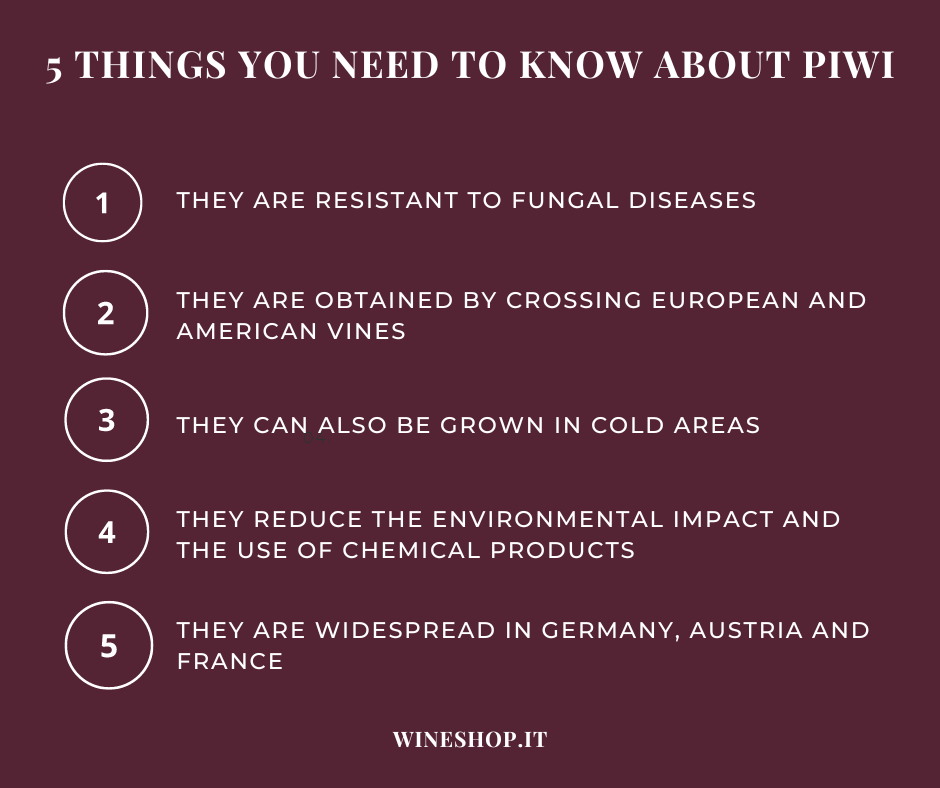What are PIWI vines and wines?
The theme of PIWI vines and wines is extremely topical and will be in the future of viticulture and world oenology. In this article, we want to explain the meaning of PIWI: what does PIWI mean? What are the characteristics of PIWI vines and wines? What are the most common PIWI in Italy and in the world? What is the origin and history of PIWI vines?
Below, we answer these questions, hoping to clarify the issue.
What does PIWI mean?
The first question we need to answer is the one about the meaning of the word and the acronym PIWI. What does that mean? Let’s say that it is an acronym of the German "Pilzwiderstandfähig". Not one of those words that you can easily remember, especially for those who do not know the German language. For this reason, we will reveal its translation. "Pilzwiderstandfähig" can be translated as "fungal resistant". PIWI are varieties that are characterized by a high resistance to fungal diseases.
What are PIWI vines?
PIWI vines are the result of cross-breeding (or multiple crossing) between European and American (or Asian) vine varieties. For this reason, they are also called hybrid vines. The goal of crossing is to combine the organoleptic qualities that characterize European vines with the great ability to resist the diseases of the vine that, instead, characterizes American vines.
The process through which these vines are obtained is still the subject of specific scientific studies. Usually, PIWI are born by pollination and natural selection. Two other possible practices, which, at the moment, are not allowed and that are at the center of a heated debate, are Cisgenesis and Genome Editing.
What are PIWI wines?
The easiest question to answer. PIWI wines are wines made from the vinification of PIWI grapes.
What are the advantages of PIWI vines?
The advantages of PIWI vines are closely linked to their resistance to fungal diseases and low temperatures. This feature of PIWI allows a lower use of pesticides, less phytosanitary interventions in the vineyard and a lower use of chemical products, for a lower environmental impact, greater sustainability and a reduction in the costs of vineyard management.
Moreover, their characteristic resistance to cold allows the cultivation of these varieties even in areas traditionally not suitable for viticulture. PIWI vines are not completely resistant to all vine diseases. Depending on the variety, there are fungal diseases that can also affect resistant vines. In any case, their degree of resistance is such as to reduce the use of chemical products.
What is the history and origin of PIWI vines?
The origin of PIWI and experiments on this type of grape is not recent. It dates back to the period between the nineteenth and twentieth centuries, when, especially in France, some winemakers and experts combined European and American vines to create varieties resistant to phylloxera that, at that time, was seriously affecting European viticulture. Since then, attempts to create hybrid vines have followed one another over time.
In which countries are PIWI vines grown? Which are the most cultivated PIWI in Italy?
Germany, France, Austria and Switzerland are the countries where PIWI vines and wines are most common. In Germany, and in part also in Austria, specific PIWI varieties can be included in the ampelographic basis of the National Denominations and Appellations.
In Italy, PIWI vines are mainly cultivated in Trentino Alto Adige, Friuli Venezia Giulia, Veneto, Lombardia, Emilia Romagna, Marche and Abruzzo. Among the most common varieties, which cannot be used for the production of DO wines, there are Solaris and Bronner, white berried grapes of German origin.
Did you know PIWI? What do you think?
If you liked our article and if you want to continue to receive news, updates and curiosities about the world of wine, subscribe to the Wineshop.it wine newsletter. Lots of content and offers await you!










